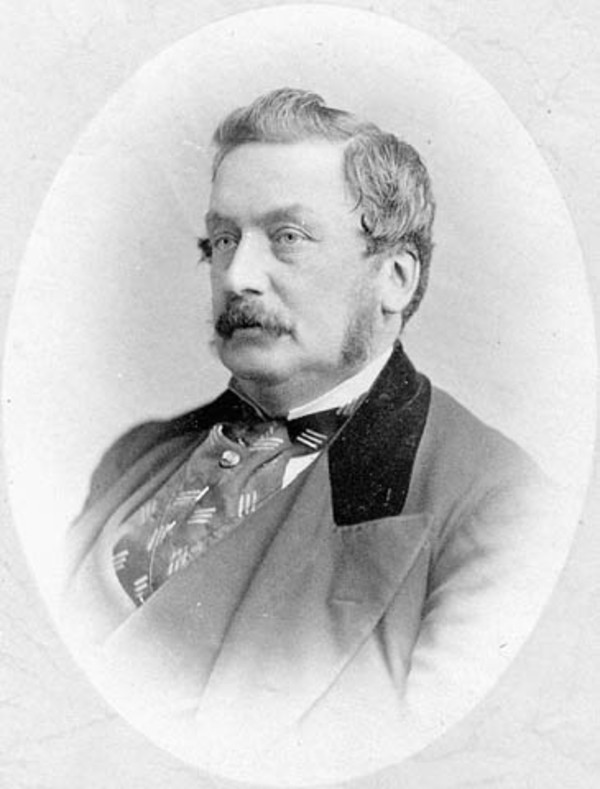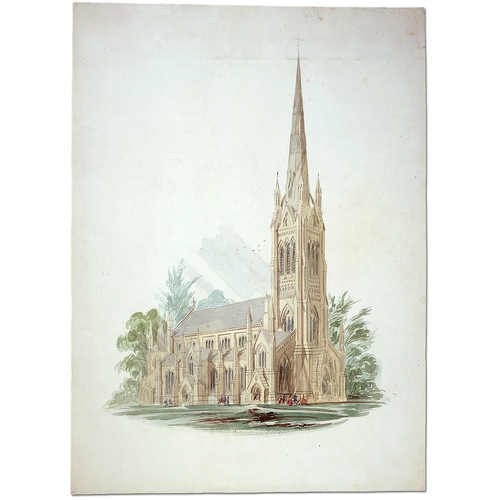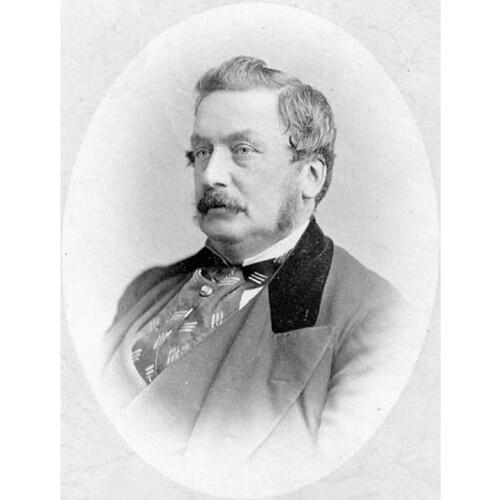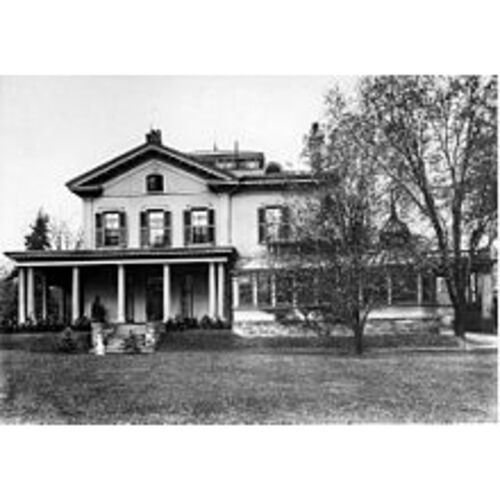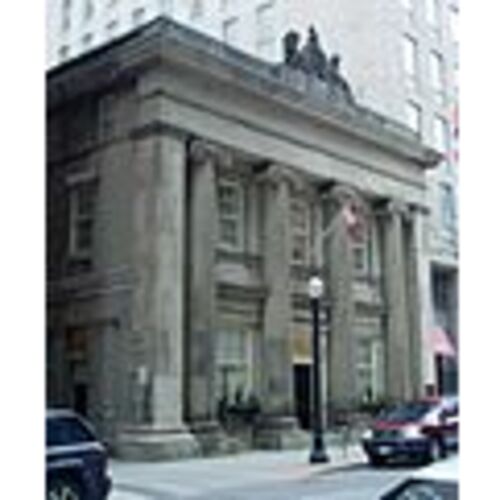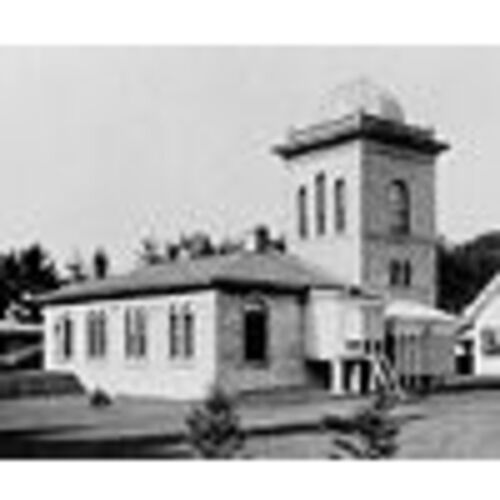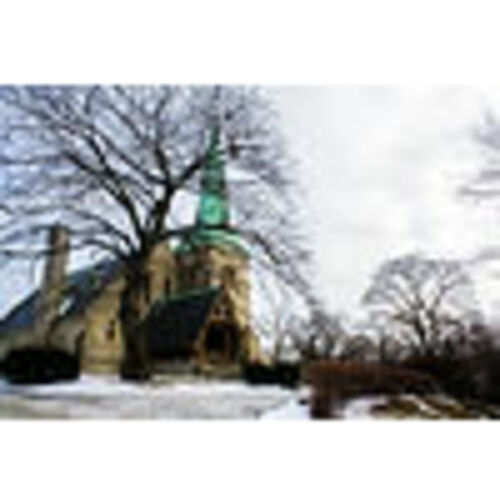CUMBERLAND, FREDERIC WILLIAM, engineer, architect, railway manager, and politician; b. 10 April 1820 in London, England, son of Thomas Cumberland; m. 30 Sept. 1845 Wilmot Mary Bramley, and they had four daughters and three sons, including Frederic Barlow; d. 5 Aug. 1881 in Toronto, Ont.
Although the family of Frederic William Cumberland claimed descent from a bishop of Peterborough, England, they would appear to have had more humble origins. Cumberland’s father was servant to the vicar of Kippax (West Yorkshire) until about 1819 when he became a messenger at the Irish Office, first in London and later, from 1828 to 1833, in Dublin. He then had the post in London of office-keeper for the Colonial Office until 1839. Frederic was educated by a minister who probably ran a parish school in Dublin. In 1834–35 he studied at King’s College School, the junior school of King’s College, University of London, before apprenticing with William Tress, civil engineer, for five years. Some time after 1834 he met Sir Charles Barry, for whom he may have worked on the Houses of Parliament at Westminster.
Part of Cumberland’s work as an apprentice was to prepare surveys for the Tithe Commutation Commission and for various railways. He soon obtained posts as assistant engineer on the Plymouth branch of the Great Western Railway and later on the London and Birmingham Railway, and he may also have designed some railway stations. By 1843, on Lord Stanley’s recommendation, he had been appointed to the engineering department of the Admiralty as first assistant at the dockyards at Chatham, and he was later promoted to the larger Portsmouth dockyards; in these positions he constructed both dry docks and fortifications, attaining such expertise in the building of permanent foundations that he continued to be consulted on the subject for a decade after coming to Canada. From 1845 to 1847, while at the dockyards, he may have assisted in editing and he contributed to the professional journal of the Royal Engineers.
Cumberland’s marriage in 1845 connected him with Toronto and was probably a major factor in his emigration. One of his wife’s sisters, Matilda Ann, was the second wife of Thomas Gibbs Ridout*, first cashier (general manager) of the Bank of Upper Canada. Another sister, Julia Elizabeth, married as her second husband, Joseph Davis Ridout, prominent businessman of the city; after Julia Elizabeth’s death in 1852 Joseph married Cumberland’s sister, Caroline. In 1847 the Cumberlands came to Toronto via New York City and the Erie Canal. Soon after his arrival Cumberland worked as a surveyor laying out the intersection of Bloor and Yonge streets, as an evaluator for the British America Fire and Life Assurance Company, and as county engineer for the united counties of York and Peel from 1848 to 1854.
Cumberland’s primary profession, however, was that of architect. Before 1850 he probably constructed the wall around the Provincial Lunatic Asylum at Toronto (999 Queen Street West), a building which John George Howard had designed and built in 1845–49. In 1850 he formed a partnership with Thomas Ridout, a son of Thomas Gibbs Ridout. Before the partnership was terminated in 1852, Cumberland and Ridout designed a number of important buildings. The first of these was St James’ Cathedral in Toronto, a commission Cumberland himself had won in competition with ten other entrants in 1849. The cathedral, of white brick with stone trim, as were most of Cumberland’s buildings, was Gothic in style. The main part of the work was completed by 1853; lack of funds caused a delay in the completion of the tower and spire until 1874. Cumberland also designed the now demolished St James’ School for the cathedral. A second commission received by the partnership was for a series of interconnected buildings to house the Normal and Model schools at Toronto, built in 1851–52 (now demolished except for the main façade). The structure had a Roman exterior and a Gothic interior; a third storey was later added which somewhat spoiled the design. In 1851 Cumberland also designed the York County Court House. On this commission he ran into a dispute over fees; he had charged only two and a half per cent instead of the customary five per cent because he was county engineer. As soon as the building was completed his office was abolished and he then demanded the full fee; a compromise was eventually effected. About the time the partnership was dissolved in 1852, Cumberland designed another important Toronto building, the seventh Post Office, in classic style with Ionic columns; it still stands on Toronto Street.
In 1852 Cumberland formed a new partnership with William George Storm*, a pupil of Toronto architect William Thomas*. Storm had already begun to work for Cumberland in 1850 on St James’ Cathedral. Their partnership lasted until 1866–67, when Cumberland became totally occupied with railway management, and it is difficult to separate their work while the partnership lasted. Their first major commission was the now demolished Toronto Mechanics’ Institute (after 1883 the Toronto Public Library), which was built in 1853–54 in the Renaissance palazzo style. As a member of the executive of the institute, Cumberland did not charge either for drawing plans or for superintending construction. The magnetical observatory followed in 1854–55 (still on the grounds of the University of Toronto) as well as various offices such as the York Chambers (now demolished) and alterations to Government House (also now demolished).
In 1856 came the commission for what was probably to be his major work, University College in the University of Toronto. As preparation for designing the building, the university authorized Cumberland to tour the British Isles and France where he was able to see the main ideas being developed in architecture; he was greatly influenced by art historian John Ruskin’s theories, particularly as they were being applied in the new University Museum at Oxford. Despite the attempts by Governor General Edmund Walker Head* to suggest alterations in the design, University College is largely Norman in style, but it nevertheless represents the introduction into Canada of the High Victorian era of architecture, which incorporated ideas from many periods to achieve picturesque effects. The building, which was constructed in 1856–59, was so successful and so well in advance of the ideas of the era in incorporating stylistic innovations with a functional design that, after it was severely gutted by fire in 1890, it was restored on much the same lines. Financially, the project was less successful, for Cumberland ran into major difficulties with the university over costs.
Meanwhile he had become involved in several other buildings of importance in Toronto, including the Queen Street Methodist Church (1857), the beautiful Gothic chapel of St James-the-Less in St James’ Cemetery (1857–61), and the imposing centre portion of Osgoode Hall (1857–60) with its magnificent library, one of the finest rooms in a Canadian building. Storm played an increasing part in the construction of these buildings. Cumberland designed many large residences in the city, all of which are now demolished, including homes for Professor George Templeman Kingston, Casimir Stanislaus Gzowski*, Thomas Gibbs Ridout, John Ross*, and other prominent citizens; he also designed his own spacious home, Pendarves (1860), still standing in the University of Toronto grounds. Many of these residences were pleasing, spacious, mid-Victorian houses, in the style of Tuscan villas.
Outside Toronto Cumberland was also active. With Thomas Ridout he had a branch operation in Hamilton in 1850–51 and he designed buildings across the province. These included the Haldimand County Court House at Cayuga and the Gothic Church of the Ascension at Hamilton (both 1850–51), the Hamilton Central School (1851–53), and the Ontario County Court House at Whitby (1853), a fine Doric-domed structure. The Hamilton Post Office (1854–56) was one of other buildings that no longer stand.
Any evaluation of Cumberland’s work would place him as one of the most important Canadian architects. A man of great imagination, who could implement the familiar styles demanded by his clients, he was also instrumental in introducing High Victorian picturesque eclecticism to Canada. His work was as successful financially as it was architecturally. His average income in the early 1850s ranged from $8,000 to $12,000 and one year went as high as $16,000. Thus when he abandoned the architectural profession he did so not because of any lack of success. The difficulties he had frequently encountered over fees were part of the reason. The recession of 1857, moreover, had halted construction and by 1860 Toronto, the site of the majority of his commissions, had erected most of the principal structures that it would need for some time.
Cumberland was also attracted by the challenge and excitement of railways and thus gradually moved from architecture to full-time railway management. In 1852 the floundering Ontario, Simcoe and Huron Railroad Union Company (renamed the Northern Railway Company of Canada in 1858) appointed Cumberland chief engineer. He held this post for two years and then joined the company again: as a director in 1857, as vice-president in 1858, and then from 1859 until his death as general manager or managing director. He was also agent for the Port Hope, Lindsay and Beaverton Railway (1860), director of the North-West Navigation and Railway Company (1863) and of the Interoceanic Railway Company (1872), and manager of the Northern Extension Railways (1870–75) prior to its merger with the Northern and of the Hamilton and North Western Railway (1879–81) which also combined with the Northern. Along with Charles John Brydges of the Great Western and Grand Trunk railways, and Thomas Swinyard of the Great Western, Cumberland was an early example of the professional manager in an era dominated by amateurs. In part because he could learn from his mistakes, he also ranks as one of the more successful managers in 19th-century Canada.
As chief engineer of the Ontario, Simcoe and Huron from 1852 to 1854 Cumberland, in order to satisfy the Board of Railway Commissioners, renegotiated existing open-ended contracts and instituted a system in which fixed-price contracts were obtained by tender. The engineering staff, previously controlled by the contractors, was placed under the supervision of the chief engineer who reported to the company’s board of directors. Control was thus shifted from the contractors to the Canadian directors. Cumberland also encouraged through traffic rather than local trade and he assured the directors that he had upgraded the standards of construction. Stepping back from active involvement in 1854, he watched the railway slide towards bankruptcy by 1857. The directors lacked managerial experience, construction remained shoddy, and the through traffic ran at a loss. In 1859 Cumberland returned as general manager. The Canadian government, in order to protect its investment of £578,000 in a mortgage on the Northern, removed control of the railway from the company on 4 May 1859. A week later, after the company agreed to meet conditions demanded by the government, an order in council returned control of the railway to the company (an act passed in 1860 confirmed the transfer). Among the stipulations of the agreement between the company and the government was the negotiation of a financial arrangement between the two largest investors, the government and the British bondholders; in exchange for an additional £250,000 investment, the bond-holders were given votes in the election of directors proportionate to their investment, and thereby acquired control of the railway.
As general manager, Cumberland, given a free hand by the bondholders and aware of past mistakes, instituted a number of operational changes which formed the basis for his later claim that no railway in Canada had been better managed. Since he held the bondholders’ proxies Cumberland appointed and controlled the Canadian directorate and was able to streamline the entire managerial structure. One of the first managers to de-emphasize through traffic, he cultivated instead the remunerative local trade. To guarantee high quality construction, he closely supervised all renovations, new construction, and purchases of rolling-stock. He expanded only when forced to by competition or by the depletion of lumber, the road’s main freight, near existing track. In part because of Cumberland’s sound and conservative management, the Northern played an important role in opening Toronto’s rich hinterland.
Unlike his operational methods, Cumberland’s financial policy met with much criticism. To discourage excessive expansion, the Northern’s capital account, money invested in the railway through stocks and bonds, had been closed in 1860 by the act passed that year. This closing forced Cumberland to pay for all rail and stock maintenance and for expansion out of current working expenses. As a result he quickly re-established a sizable floating liability which he attempted to reduce only after the annual payment of the principal and interest to British bondholders; the payment of interest on various provincial government loans and also the payment of dividends to shareholders followed after the liability in priority. The bondholders profited from this system and increased their investment at crucial times, but the provincial government and shareholders saw little direct return. Aware of the importance of the bondholders’ investment, the government gave the arrangement its “tacit concurrence.” The private shareholders, who owned half of the shares, and the governments of Toronto and Simcoe County, who owned the other half, could only fume; they too desired the expansion of the road for economic and political reasons, and realized the need for capital from the London market. After Cumberland’s death, the government, despite strong pressure from the bondholders, refused to grant any further public assistance to the road. Bereft of Cumberland’s advocacy and managerial ability, the Northern lost its independent status and became part of the Grand Trunk system in 1888.
Cumberland’s railway interests greatly affected the political activities he took up. Indeed, the railway, not the electorate, was his constituency. Although he represented Algoma as a Conservative in the Legislative Assembly of Ontario from 1867 to 1875 and in the House of Commons in 1871–72, he rarely visited the constituency and had little contact with the local electorate. He spent Northern money to finance his own elections as well as the election of the Northern’s president, John Beverley Robinson*, to succeed him in the House of Commons for Algoma in 1872 and that of their ally, Sir Francis Hincks, for Renfrew North in 1869. He also used Northern money for donations to the Conservative party, for such purposes as testimonials to Sir John A. Macdonald* and the founding of a Conservative newspaper, the Mail, in 1872. He casually defended the spending of over $16,000 in this way by stating that “in those matters” he was regarded as a representative of the railway.
Parliamentary and community support was also acquired by wining and dining mps and prominent businessmen, hiring a federal deputy minister of justice to expedite legislation for the railway in 1868, distributing bribes for municipal bonuses, and promising townships kickbacks from government subsidies. Of questionable ethics, too, was Cumberland’s use of over $7,000 of the Northern’s money to purchase personal shares in the steamboat Chicora. None of this conduct was particularly unusual. When these details surfaced, during a federal Liberal government investigation in 1877, George Laidlaw felt they were just “a little point gained by the Ministerialists” which would not harm the Conservatives in the ensuing elections. He was right. Cumberland’s personal image, however, was tarnished. Despite many attempts, he never regained the position of provincial aide-de-camp to the governor general, an office he held from 1865 until 1878. Nor, despite hints from Cumberland, did Macdonald provide a remunerative position to which the beleaguered manager could retire in his last years.
Cumberland’s interests in architecture, railway management, and politics would seem to have been enough to occupy any man; he was, however, also involved in an amazing variety of activities around Toronto. He was a promoter and director of the Niagara Navigation Company, along with his son Barlow and Frank Smith*, as well as a director of the Merchants’ Express Company and the Rama Timber Transportation Company. Active in banking, he was an incorporator and director of the unsuccessful Bank of Canada in 1858, along with Angus Morrison, William Cayley, and William Henry Boulton*; a director of the Imperial Guarantee and Loan Society; and a director of the Canadian Bank of Commerce from 1871 to 1877. Attracted to military life, he organized the 10th Battalion Volunteer Militia Rifles (later the Royal Grenadiers) in 1861–62 and became its first lieutenant-colonel. When the battalion ran into difficulties in 1880, he reassumed the lieutenant-colonelcy to reorganize it. In 1866 he had also been active in arranging military transportation by rail during the Fenian raids.
A member of the Church of England, Cumberland was active in synod affairs and he generously allowed the congregation of St Stephen’s-in-the-Fields to use his house for a year after the church burned in 1865. He held numerous honorific posts: for example, on the local committee of the Agricultural Association of Upper Canada, as Canadian commissioner to the Great Exhibition in London in 1851, and as organizer of the reception for the Prince of Wales during his visit to Toronto in 1860. He became a life member of the mechanics’ institute in 1848 and held many posts with it, including the presidency in 1852–53. In 1849, together with Sandford Fleming*, Kivas Tully*, and others, he organized the Canadian Institute, of which he was corresponding secretary in 1851–52, vice-president in 1852–53, and recording secretary in 1854–56.
Cumberland was a member of the Toronto Board of Education and wrote a column for his friend Egerton Ryerson in the Journal of Education for Ontario for many years. He was also a member of the corporation of Trinity College in 1869–70 and of the governing body of Trinity College School, Port Hope, from 1870 until his death. In spite of his disagreements over the costs of University College, he was a member of the senate of the University of Toronto from 1853 until he died. In 1864 he was admitted as a student to Osgoode Hall, but did not complete a legal education.
Cumberland was prominent in the St George’s Society of Toronto and was its president in 1855–56. He was a noted freemason, reorganizing St Andrew’s Lodge and becoming its master about 1878, as well as becoming deputy grand master of the Toronto District. A keen sportsman, he was an active cricketer and president of the Toronto Cricket Club when he died. In 1881 he also helped incorporate the Ontario Jockey Club and became its first president. Any man as active as Cumberland, however, would naturally arouse opposition. As the Globe noted in its obituary, “he was a man of strong individuality, and in the positions which he occupied necessarily excited a good deal of antagonism.” Cumberland’s exact wealth is impossible to determine as he placed most of his funds under a deed of trust in 1870 and the evaluation of his estate, which excluded all real estate, amounted to only $36,965. Certainly his home was not only one of the major social centres but also one of the most impressive dwellings in the city. Cumberland made substantial contributions to almost every aspect of life in Toronto, designing many of its important buildings, developing its communications, and extending the range and improving the quality of its educational, cultural, and sporting activities.
[The AO acquired in 1979 the Horwood collection of architectural drawings which includes a substantial number by the Cumberland and Storm partnership. A full evaluation of each individual’s contribution to the partnership must await an analysis of these drawings. f.h.a. and p.b.]
Frederic William Cumberland was the author of “Iron roofs erected over building slips, nos 3 and 4, in Her Majesty’s Dockyard, Portsmouth,” Papers on Subjects Connected with the Duties of the Corps of Royal Engineers (London), 9 (1847): 59–65; and of “Some notes of a visit to the works of the Grand Trunk Railway, west of Toronto, February, 1855,” Canadian Journal, 3 (1854–55): 225–27.
AO, Frederic William Cumberland letters (uncatalogued); Diaries of Mrs Frederic William Cumberland (uncatalogued); MU 469–87; 2390–98; 2697, 2700, 2702, 2749, 2752; RG 49, I-7-B-3, 4, Northern Extension Railways, folder 1. MTL, Sir Thomas Galt papers; John Harvie papers; Northern Railway of Canada papers; T. A. Reed scrapbooks. PAC, MG 24, E17, 2; RG 30, 121, 167, 197. UTA, A70-0005, Senate, Minutes, 1850–73. UWO, Thomas Swinyard papers. York County Surrogate Court (Toronto), no.3122, Will and inventory of F. W. Cumberland, 13 Aug. 1881 (mfm. at AO). Can., Parl., Sessional papers, 1877, VII: no.10. Globe, 2 Feb. 1855, 6 Aug. 1881. Toronto Daily Mail, 6 Aug. 1881. Canadian directory of parl. (J. K. Johnson), 146. Chadwick, Ontarian families, I: 36–37, 42–43. Cyclopædia of Canadian biog. (Rose, 1886), 705–7. Dominion annual register, 1880–81: 404. W. H. Smith, Canada: past, present and future, being a historical, geographical, geological and statistical account of Canada West (2v., Toronto, [1851–52]), I: 165. Alfred Sylvester, Sketches of Toronto, comprising a complete and accurate description of the principal points of interest in the city, its public buildings . . . (Toronto, 1858). [G. P. Ure], The hand-book of Toronto; containing its climate, geology, natural history, educational institutions, courts of law, municipal arrangements . . . (Toronto, 1858). Eric Arthur, Toronto, no mean city ([Toronto], 1964). M. E. Arthur, “The frontier politician,” Aspects of nineteenth-century Ontario: essays presented to James J. Talman, ed. F. H. Armstrong et al. (Toronto and Buffalo, N.Y., 1974), 278–96. Currie, Grand Trunk Railway. Alan Gowans, Building Canada: an architectural history of Canadian life (Toronto, 1966). Hist. of Toronto and county of York, II: 36–37. S. G. Morriss, “The church architecture of Frederic William Cumberland” (2v., ma thesis, Univ. of Toronto, 1976). Robertson’s landmarks of Toronto, I: 163, 165, 325; II: 801–7; IV: 35. [Brian Winter], A town called Whitby ([Whitby, Ont., 1967]). F. [H.] Armstrong, “Fred’s buildings . . . ,” Heritage Canada (Ottawa), 3 (1977), no.3: 44–47. Crawford Grier, “The right place,” Varsity Graduate (Toronto), 12 (1965–66), no.1: 97–101. S. G. Morriss, “The church architecture of Frederic William Cumberland (1820/21–1881),” Ontario Museum Assoc., Newsletter (Toronto), 4 (1975), no.3: 17–25; “The nine-year odyssey of a high Victorian Goth: three churches by Fred Cumberland,” Journal of Canadian Art Hist. (Montreal), 2 (summer 1975): 42–53. [F. N. Walker], “A doorway made him famous,” Univ. of Toronto Bull. (Toronto), 54 (1953–54): 99–100; “Doorways that welcome,” Canadian Banker, 66 (1959), no.1: 64–79.
Cite This Article
Frederick H. Armstrong and Peter Baskerville, “CUMBERLAND, FREDERIC WILLIAM,” in Dictionary of Canadian Biography, vol. 11, University of Toronto/Université Laval, 2003–, accessed April 29, 2025, https://www.biographi.ca/en/bio/cumberland_frederic_william_11E.html.
The citation above shows the format for footnotes and endnotes according to the Chicago manual of style (16th edition). Information to be used in other citation formats:
| Permalink: | https://www.biographi.ca/en/bio/cumberland_frederic_william_11E.html |
| Author of Article: | Frederick H. Armstrong and Peter Baskerville |
| Title of Article: | CUMBERLAND, FREDERIC WILLIAM |
| Publication Name: | Dictionary of Canadian Biography, vol. 11 |
| Publisher: | University of Toronto/Université Laval |
| Year of revision: | 1982 |
| Access Date: | April 29, 2025 |


